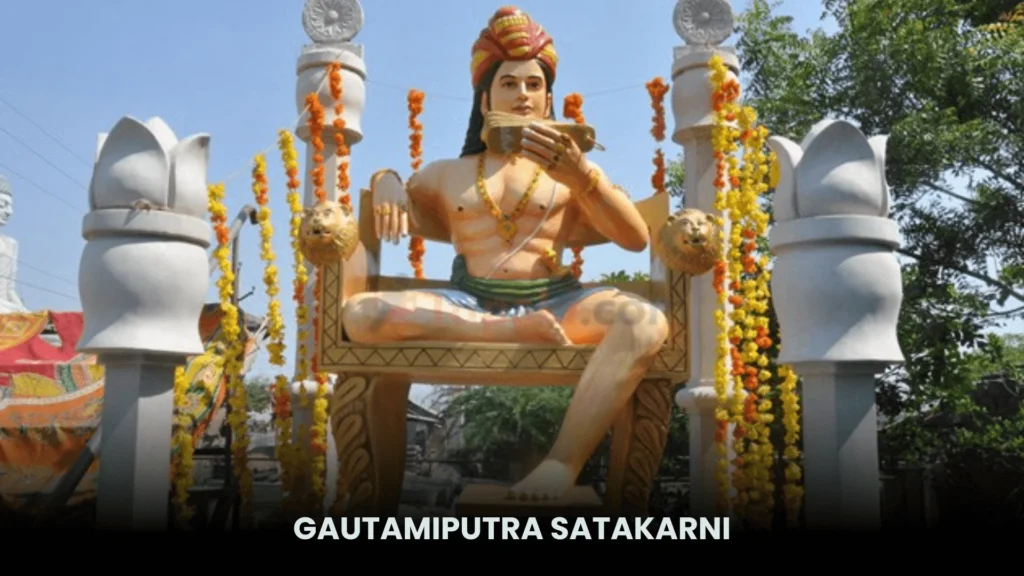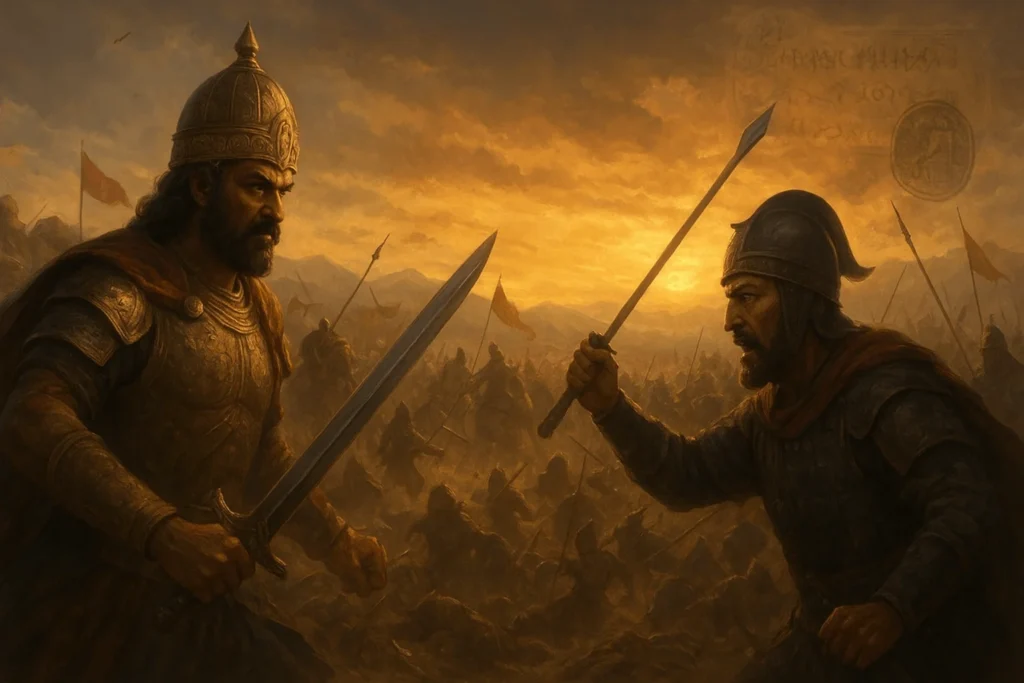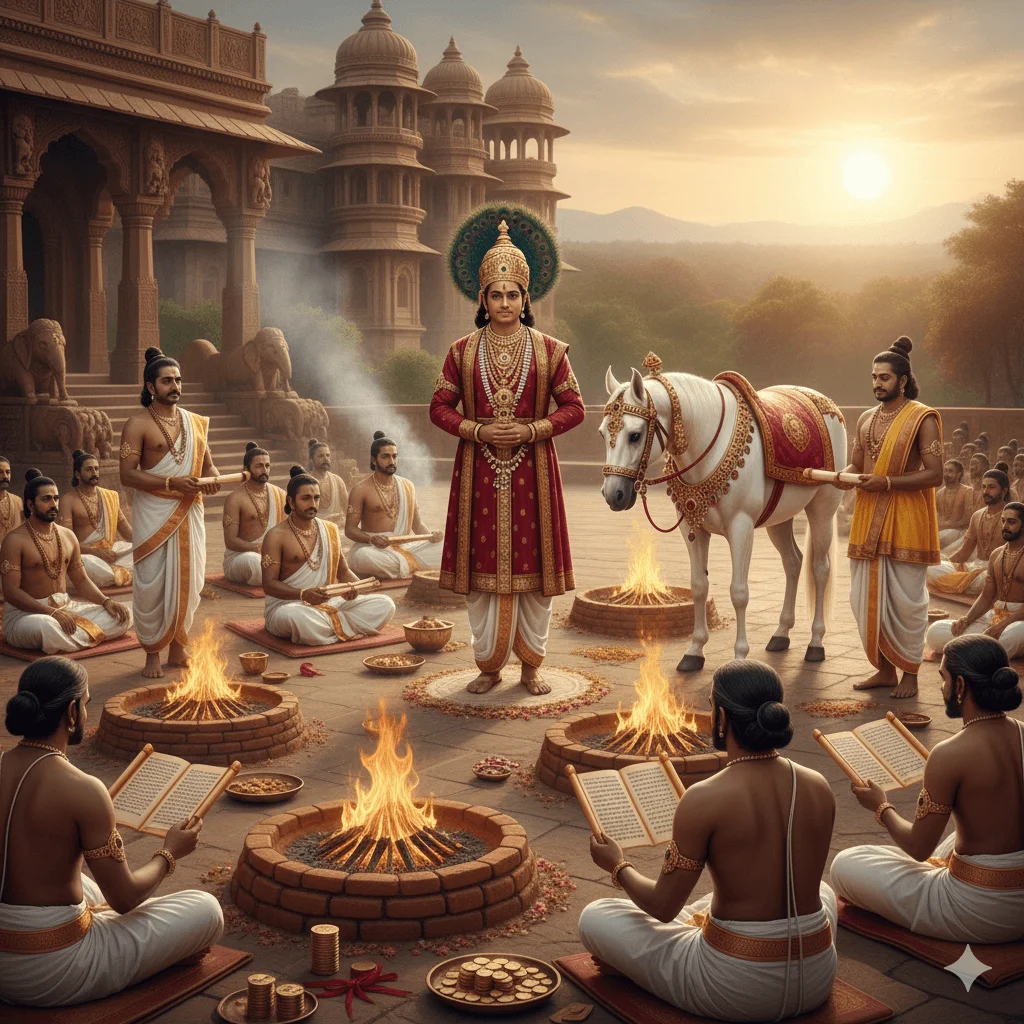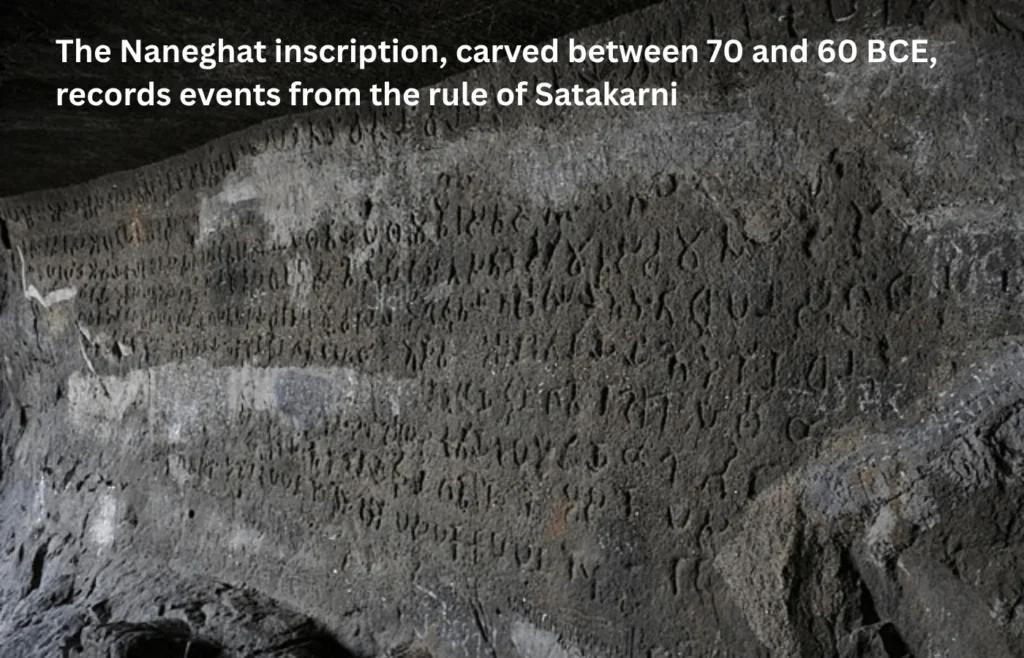
Introduction
Gautamiputra Satakarni, often hailed as the most illustrious monarch of the Satavahana dynasty, occupies a towering position in the political and cultural history of ancient India. Ruling in the 1st–2nd century CE, he is remembered not merely as a powerful conqueror but also as a restorer of indigenous Indian traditions during a period when foreign powers such as the Shakas (Western Kshatrapas) had established a stronghold over large parts of the subcontinent. His reign marked a decisive turning point that revived the prestige of the Satavahanas and strengthened Deccan’s role as a bridge between the northern and southern cultural spheres of India.
The importance of Gautamiputra Satakarni extends far beyond the boundaries of the Deccan. His successful campaigns against the Western Kshatrapas and his consolidation of power across Maharashtra, Malwa, Gujarat, and Andhra Pradesh re-established a native Indian dynasty’s dominance over regions that had fallen under foreign sway. This restoration not only ensured political stability but also safeguarded the socio-religious fabric of Indian society, reinforcing Brahmanical traditions while maintaining a remarkable spirit of religious tolerance. His rule exemplifies how the Deccan emerged as a dynamic centre of power, economy, and culture in the centuries after the Mauryas and Kushanas.
Much of what we know about Gautamiputra Satakarni comes from a careful study of archaeological and literary sources. The most celebrated among these is the Nasik inscription of his mother, Queen Gautami Balashri, which extols him as a “destroyer of the Shakas, Yavanas, and Pahlavas” and portrays him as a ruler of unparalleled strength and moral integrity. His wide circulation of coins—found across western, central, and southern India—provides concrete evidence of the vast territorial expanse under his control and his economic influence in maritime and inland trade networks. Additionally, references in the Puranas and other classical texts help historians piece together the chronology of his reign and its broader impact.
By combining epigraphic, numismatic, and literary evidence, historians today view Gautamiputra Satakarni not only as the mightiest Satavahana king but also as a symbol of resistance and revival in Indian history. His legacy illustrates the resilience of regional powers in maintaining cultural continuity and political strength during an era of foreign incursions, making him a figure of lasting significance in India’s historical narrative.
Historical Background
Rise of the Satavahana Dynasty
The Satavahana dynasty emerged in the Deccan during the late 3rd century BCE, at a time when the political landscape of India was undergoing dramatic change. With the Mauryan Empire’s collapse, the centralized administration that once bound much of the subcontinent together fragmented into regional powers. In this atmosphere, the Satavahanas rose gradually from local chieftains to sovereign rulers. Their ascendancy signaled the Deccan’s growing role in shaping pan-Indian history, bridging the north and south both politically and culturally.
Strategic Position of the Deccan Plateau
One of the dynasty’s greatest strengths lay in its geographical position. The Satavahana domain spanned the heart of the Deccan plateau, including the fertile Godavari valley and trade-rich western regions. Control over this region meant access to both the eastern seaboard, linking them with Southeast Asian maritime trade, and the western ports, which were key to Indo-Roman commerce. Their territory also connected the Gangetic north with the Tamil south, turning the Satavahanas into crucial intermediaries of cultural and commercial exchange.
Challenges from Foreign Powers
However, this strategic advantage also attracted formidable rivals. By the early centuries of the Common Era, foreign powers such as the Indo-Scythians (Shakas) and later the Western Kshatrapas had expanded deep into western and central India. The Western Kshatrapa ruler Nahapana, in particular, had extended his sway into territories once under Satavahana influence. His coins, widely circulated across Gujarat and Maharashtra, stood as proof of this political and economic takeover. The Shakas also controlled important trade routes, undermining Satavahana prosperity and prestige.
Decline before Gautamiputra Satakarni’s Rise
The weakening of Satavahana authority during this phase was not just territorial but also symbolic. The dynasty’s diminished presence in western India eroded its claim as a unifying force in the Deccan. Local chieftains and rival powers gained influence, while foreign dynasties asserted dominance over sacred and commercial spaces long associated with Satavahana patronage. By the time Gautamiputra Satakarni came to the throne, his dynasty’s legacy hung in the balance—its survival depending on a ruler capable of reversing decline and confronting external threats with decisive action.
It was in this turbulent backdrop, marked by loss of power and prestige, that Gautamiputra Satakarni’s leadership would redefine the fortunes of the Satavahana dynasty and restore indigenous control over the Deccan.
Early Life and Ascension
Parentage and Identity
Gautamiputra Satakarni’s very name reflects his close connection with his mother, Queen Gautami Balashri, an association rare in ancient Indian dynastic traditions. While kings were typically identified by their fathers, his consistent identification as “Gautamiputra” (son of Gautami) underscores both his mother’s prestige and her role in shaping his legacy. The celebrated Nasik inscription, commissioned by Gautami Balashri herself, highlights not only his conquests but also his personal qualities—depicting him as a just, disciplined, and courageous monarch. This maternal emphasis indicates the strong matrilineal support he enjoyed and the political legitimacy it conferred upon his rule.
Rise to the Throne
The exact circumstances of Gautamiputra Satakarni’s accession remain partly obscured, but historical sources suggest that he came to power during a period of instability when Satavahana authority was under severe pressure from external invasions and internal fragmentation. His predecessors had struggled to contain the advance of the Western Kshatrapas and other rivals, which left the dynasty weakened. When Gautamiputra assumed kingship, he inherited not a flourishing empire but a realm facing the threat of disintegration. His early reign, therefore, was marked by the challenge of consolidating authority, rallying support from loyal chiefs, and re-establishing the prestige of the Satavahana house.
Assertion of Independence and Sovereignty
One of Gautamiputra’s first acts as ruler was to decisively assert independence from foreign domination. He embarked on military campaigns to reclaim territories that had fallen under Shaka-Kshatrapa influence, particularly in western India. His victories were not merely military triumphs; they carried deep symbolic weight, representing the restoration of indigenous Indian rule over lands that had been controlled by foreign dynasties.
The Nasik inscription records that he destroyed the power of the Shakas, Yavanas (Greeks), and Pahlavas (Parthians), projecting him as a defender of dharma and a restorer of Indian sovereignty. His extensive coinage, which replaced that of the Kshatrapa ruler Nahapana in many regions, further reinforced his claim as the legitimate ruler of the Deccan and its adjoining territories. Through these measures, Gautamiputra transformed the Satavahana dynasty from a declining regional power into a resurgent force capable of challenging the strongest adversaries of its time.
Legacy of Ascension
The success of Gautamiputra Satakarni’s early reign laid the foundation for his later achievements. By reasserting Satavahana independence and reviving the dynasty’s prestige, he created the conditions for stability, prosperity, and cultural patronage that followed. His ascension was thus not a routine transfer of power but a turning point in Deccan history, ensuring that the Satavahanas would once again occupy a central place in India’s political landscape.
Military Achievements and Expansion
Triumph Over the Western Kshatrapas
The defining moment of Gautamiputra Satakarni’s reign was his decisive victory over the Western Kshatrapas, led by their formidable ruler Nahapana. This campaign was not just a territorial conquest but a symbolic assertion of native sovereignty against powerful foreign dynasties. Inscriptions and coins provide compelling evidence of this triumph, with Satavahana forces reclaiming regions long dominated by the Kshatrapas. The victory dismantled their stronghold in western India and marked the beginning of an era in which indigenous rule regained prominence.

Revival of Satavahana Power in the Deccan
By defeating Nahapana and subduing rival powers, Gautamiputra restored the Satavahanas to their former prestige. The Deccan, which had previously been politically unstable, was unified under his leadership. His control extended over critical regions, including Maharashtra, Malwa, Gujarat, and Andhra, creating a vast and strategically significant empire. These territorial gains were not mere additions to the map—they secured trade routes, agricultural lands, and cultural centers that strengthened the dynasty’s economic and political foundation.
Expansion into Strategic Regions
His conquests in Malwa and Gujarat gave the Satavahanas access to fertile lands and important urban centers, while control over Andhra and Maharashtra consolidated their dominance across the central and southern subcontinent. This expansion positioned the Satavahanas as a formidable power, balancing northern dynasties like the Kushanas and safeguarding the Deccan as a cultural and political hub of the subcontinent.
Maritime Influence and Trade
Beyond land conquests, Gautamiputra is credited with fostering naval strength and maritime trade. By securing coastal territories along western India, the Satavahanas were able to oversee lucrative trade routes across the Arabian Sea, linking the Deccan to markets in Rome, Southeast Asia, and beyond. Archaeological discoveries, including Roman coins in Satavahana territories, testify to this flourishing international commerce. His reign ensured that the Deccan was not isolated but actively engaged in the global exchange of goods such as cotton, spices, and precious stones.
Patron of Brahmanical Traditions
While expanding his empire, Gautamiputra also positioned himself as a protector of indigenous religious and social traditions. His campaigns were often framed as battles not only for political dominance but also for the preservation of Brahmanical values against foreign cultural influences introduced by the Indo-Scythians and other invaders. By patronizing Brahmanical institutions and supporting Vedic practices, he reinforced the cultural identity of his subjects while consolidating his own legitimacy as a ruler rooted in dharma.
Lasting Impact of His Conquests
The military achievements of Gautamiputra Satakarni were not fleeting victories but transformative shifts in the balance of power in India. His ability to combine military strength, territorial consolidation, and cultural guardianship created a stable foundation for the Satavahana dynasty’s golden age. He emerged not only as a conqueror but as a unifier, securing the Deccan’s place as a vibrant political and economic force in ancient India.
Administration and Governance
Capital at Pratishthana
Gautamiputra Satakarni established Pratishthana (modern Paithan) as the political and administrative heart of the Satavahana empire. Strategically located along the Godavari River, Pratishthana served not only as a military and political center but also as a hub of economic and cultural activity. Its location facilitated oversight of the Deccan plateau, trade with northern and southern India, and access to maritime routes along the western coast. The city became a symbol of Satavahana resurgence, reflecting the stability and authority restored under Gautamiputra’s leadership.
Structure of Administration: Centralized and Regional Governance
The Satavahana administration under Gautamiputra balanced centralized authority with regional autonomy. While the king exercised supreme power in matters of military strategy, revenue collection, and diplomacy, local governance was entrusted to loyal chieftains and regional administrators. This system allowed the Satavahana empire to manage a vast territory efficiently, ensuring that distant regions such as Malwa, Gujarat, and Andhra remained integrated into the imperial framework without overburdening the central administration.
Role of Queens and Royal Family
The royal family played a significant role in governance, with Gautamiputra’s mother, Queen Gautami Balashri, standing out as a central figure. Inscriptions credit her with overseeing charitable activities, religious patronage, and, indirectly, state affairs, emphasizing the political influence exercised by royal women in Satavahana society. Such involvement strengthened internal cohesion, legitimized authority, and facilitated the king’s consolidation of power during both military campaigns and domestic governance.
Patronage of Religion and Brahmanical Rituals

Gautamiputra Satakarni actively supported Brahmanical rituals, reinforcing both religious and political legitimacy. The king is noted for performing significant Vedic sacrifices such as the ashvamedha (horse sacrifice), which symbolized sovereign authority and cosmic order. Additionally, he granted lands and wealth to Brahmins, demonstrating the symbiotic relationship between religious institutions and state power. This patronage not only solidified his support among influential social groups but also reinforced cultural continuity during a time when foreign dynasties had challenged indigenous traditions.
Economic Administration: Taxation and Land Grants
The Satavahana economy under Gautamiputra combined agricultural productivity, trade, and taxation to sustain the empire. Land revenue formed the backbone of the state treasury, while systematic land grants encouraged settlement and cultivation in newly reclaimed or peripheral territories. By granting land to Brahmins and loyal officials, Gautamiputra strengthened administrative networks and incentivized loyalty, while simultaneously promoting religious and educational institutions. Trade, both inland and maritime, complemented the agrarian economy, further enhancing the empire’s wealth and stability.
Legacy of Governance
Through a combination of centralized control, regional delegation, religious patronage, and economic foresight, Gautamiputra Satakarni established a robust administrative framework that allowed the Satavahana dynasty to flourish. His governance reflected a careful balance of power, morality, and pragmatism, ensuring that the empire remained politically cohesive, economically vibrant, and culturally influential long after his reign.
Cultural and Religious Contributions
Patronage of Brahmanism with Religious Tolerance
Gautamiputra Satakarni’s reign is distinguished not only by his military and administrative accomplishments but also by his active support of religious and cultural life. While he was a prominent patron of Brahmanism, supporting Vedic rituals and the Brahminical elite, he demonstrated remarkable tolerance toward other religious traditions, including Buddhism and Jainism. This inclusivity allowed diverse communities to coexist under the Satavahana administration, fostering social cohesion and cultural exchange across the Deccan. His reign illustrates how political authority and spiritual patronage were intertwined, reinforcing legitimacy while encouraging intellectual and religious pluralism.
Sponsorship of Cave Temples
Gautamiputra’s cultural influence is vividly evident in his support for rock-cut cave temples, which combined architectural innovation with devotional practice. Notable examples include the Nasik Caves and the Karle (Karli) caves, where inscriptions attest to his donations and the erection of elaborate structures for religious gatherings. These caves were centers of learning, meditation, and ritual, serving both as symbols of royal patronage and as enduring testaments to the artistic and spiritual aspirations of the Satavahana period. The construction of these temples reflects an understanding of architecture not just as functional, but as a medium of cultural and religious expression.
Role of Queen Gautami Balashri in Religious Patronage
Queen Gautami Balashri, Gautamiputra’s mother, played an essential role in fostering cultural and religious activities. Inscriptions commissioned by her highlight her contributions to charitable donations, land grants to Brahmins, and support for temple constructions, further extending the royal family’s influence in both civic and spiritual domains. Her active involvement in philanthropy and religious endowments illustrates the intertwined roles of family and state in shaping the moral and cultural fabric of the empire.
Influence on Deccan Art and Architecture
The reign of Gautamiputra Satakarni marked a period of significant innovation in Deccan art and architecture. Beyond temple construction, his era saw the refinement of sculptural motifs, rock-cut reliefs, and architectural techniques that blended indigenous styles with influences from northern India and beyond. The emphasis on intricate carvings, inscriptions, and symbolic iconography in Satavahana-era caves reveals an enduring impact on later Deccan architecture, establishing standards that would influence regional art for centuries.
Legacy of Cultural Contributions
Gautamiputra Satakarni’s cultural and religious policies created a lasting legacy that went beyond military conquest and political consolidation. By supporting Brahmanical rituals, fostering religious tolerance, commissioning monumental architecture, and encouraging artistic expression, he reinforced both the spiritual and cultural identity of the Deccan. This period of cultural flourishing under his reign contributed significantly to the historical memory of the Satavahanas as not merely warriors or administrators, but as visionary patrons of Indian civilization.
Sources of Information
Nasik Inscription of Queen Gautami Balashri
One of the most authoritative sources on Gautamiputra Satakarni is the Nasik inscription, commissioned by his mother, Queen Gautami Balashri. This inscription, etched on a rock-cut cave in Nasik, extols the king’s military prowess, administrative skill, and moral virtues. It records his victories over the Shakas, Yavanas, and Pahlavas, emphasizing his role as a restorer of Satavahana power and a protector of Indian traditions. Beyond chronicling conquests, the inscription highlights Gautamiputra’s personal qualities—courage, justice, and devotion to dharma—offering historians an invaluable lens into both his character and the values of his reign.
Numismatic Evidence: Coins and Authority
Coins issued during Gautamiputra’s reign provide crucial insights into his authority, titles, and territorial influence. Silver and lead coins bear his name and honorifics, often featuring symbols of power such as the Ujjain symbol or depictions of royal motifs. Numismatic studies show that his coins circulated across Maharashtra, Gujarat, Malwa, and Andhra, reflecting both economic control and the extent of his empire. The practice of overstriking the coins of rival rulers, particularly those of Nahapana, further confirms his military successes and political dominance.
Literary References: Puranas and Later Texts
Classical literary sources, including the Puranas, complement epigraphic and numismatic evidence by situating Gautamiputra Satakarni within a broader historical and cultural context. Texts such as the Vayu Purana and Matsya Purana reference the Satavahana dynasty’s kings, corroborating their chronological position and providing information on genealogical succession. Later literary works, while composed centuries after his reign, also reflect the enduring memory of his accomplishments, portraying him as a model of kingly virtue and protector of dharma.
Archaeological Findings

Archaeological discoveries across the Deccan and western India further enrich our understanding of Gautamiputra’s reign. Excavations at Nasik, Karle, and Paithan have revealed cave temples, inscriptions, and structural remains associated with the Satavahanas. Material culture, including pottery, trade goods, and architectural fragments, provides additional evidence of the socio-economic conditions, religious patronage, and administrative organization during his rule. These findings, when combined with textual and numismatic sources, allow historians to reconstruct a multi-dimensional picture of his era.
Synthesizing the Evidence
By integrating inscriptions, coins, literary references, and archaeological findings, historians can form a coherent narrative of Gautamiputra Satakarni’s life and reign. Each source complements the others: inscriptions detail political achievements, coins indicate economic reach and legitimacy, texts preserve genealogical and cultural memory, and archaeological remains offer tangible proof of his administrative and cultural initiatives. Together, they confirm his status as one of the most influential rulers of the Satavahana dynasty and a pivotal figure in the history of the Deccan.
Legacy and Significance
Restorer of Satavahana Glory
Gautamiputra Satakarni is widely remembered as the restorer of the Satavahana dynasty’s prestige following a period of decline. When he ascended the throne, the Satavahanas faced territorial losses and political subjugation under foreign powers like the Western Kshatrapas. Through his military campaigns, administrative reforms, and strategic consolidation of territories across the Deccan and western India, he revived the dynasty’s authority and secured its position as a dominant regional power. His reign marked a turning point, transforming the Satavahanas from a declining force into a unifying political entity of peninsular India.
Protector of Dharma and Indian Traditions
Beyond political restoration, Gautamiputra is celebrated as a champion of dharma. His victories over foreign rulers and patronage of Brahmanical rituals reinforced indigenous religious practices, ensuring the continuity of Indian traditions in the Deccan. By combining military prowess with moral authority, he projected an image of a righteous king whose rule upheld both justice and cultural integrity. This balance of martial strength and ethical governance became a benchmark for subsequent rulers in the region.
Symbol of Deccan Unity
Gautamiputra’s reign also fostered a sense of regional unity in the Deccan. By reclaiming and integrating territories such as Maharashtra, Gujarat, Malwa, and Andhra, he created a cohesive socio-political framework that bridged northern and southern influences. This consolidation not only stabilized the region but also enabled economic prosperity through trade networks and facilitated the flourishing of cultural and religious activities across diverse communities. His ability to unify the Deccan under Satavahana leadership remains one of the enduring hallmarks of his legacy.
Shaping the Socio-Political Fabric of Peninsular India
The influence of Gautamiputra Satakarni extended beyond immediate territorial gains. His reign set a precedent for effective administration, regional governance, and strategic diplomacy, shaping the socio-political fabric of peninsular India for decades. Land grants, economic policies, and support for local chieftains strengthened regional administration while fostering loyalty and stability. These structural innovations ensured that the Satavahana dynasty’s achievements had a lasting impact on governance practices in the Deccan and adjacent regions.
Preservation of Memory Through Inscriptions and Legends
The memory of Gautamiputra Satakarni has been preserved through multiple channels—epigraphic records, coinage, cave inscriptions, and oral legends. The Nasik inscription of his mother, Queen Gautami Balashri, remains a particularly vivid testimony to his reign, highlighting his conquests, virtues, and dedication to dharma. Over centuries, literary works and local traditions have continued to celebrate him as a paragon of ideal kingship, cementing his status not just as a historical figure but as a cultural icon of Deccan history.
Enduring Significance
In sum, Gautamiputra Satakarni’s legacy lies in his ability to revive a declining dynasty, protect cultural traditions, and unify a diverse region, establishing enduring political and cultural foundations. His life and reign exemplify the integration of military, administrative, and spiritual leadership, making him one of the most significant rulers in the history of the Deccan and the broader Indian subcontinent.
Conclusion & FAQs
Gautamiputra Satakarni stands out as one of the most influential rulers of the Satavahana dynasty, whose reign marked a pivotal chapter in the history of the Deccan and peninsular India. Ascending the throne during a period of political fragmentation and foreign dominance, he successfully restored Satavahana authority, reclaimed lost territories, and established a stable and cohesive empire spanning Maharashtra, Malwa, Gujarat, and Andhra. His military campaigns against the Western Kshatrapas not only demonstrated strategic brilliance but also symbolized the resurgence of indigenous power in a region challenged by external influences.
Beyond his achievements on the battlefield, Gautamiputra balanced political authority with cultural and religious patronage. By supporting Brahmanical rituals, funding cave temples such as those at Nasik and Karle, and fostering religious tolerance toward Buddhism and other sects, he ensured that the Deccan thrived as both a political and cultural hub. His administration, rooted in centralized oversight yet accommodating regional governance, along with economic measures such as land grants and trade facilitation, reinforced the stability and prosperity of his empire.
Today, Gautamiputra Satakarni is remembered not only as a powerful monarch but also as a visionary leader whose reign integrated martial strength, governance, and cultural patronage. His life and accomplishments are preserved through inscriptions, coinage, literary references, and archaeological findings, reflecting a legacy that continues to resonate in the historical narrative of India. In the annals of Deccan history, he remains an enduring symbol of restored sovereignty, cultural vitality, and the consolidation of regional unity, exemplifying the multifaceted role of an ideal ancient Indian king.
